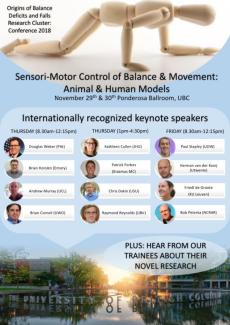OBDAF Conference and Workshop November 29-30th
November 29 - November 30, 2018
The Origins of Balance and Falls Research Cluster hosted their first annual conference and workshop on November 29th and 30th. This two-day cluster meeting was the largest the cluster has organized so far and was a huge success. With over 80 attendees over the course of the two-days, 12 internationally renowned keynote speakers provided fascinating talks on various aspects of sensori-motor control of balance and movement. Kicking off the meeting was Dr. Doug Weber from The University of Pittsburg with his talk on implantable, injectable and wearable devices for sensing and effecting neurological functions. Dr. Weber’s Rehab Neural Engineering Lab focuses on restoring sensory and motor functions post injury. As well as building hardware, researchers within the lab attempt to dig into the nervous system to find out what’s going on in order to inform the development and use of devices. The morning continued with talks from Dr. Brian Horslen, a banting post doctoral fellow at the Neuromechanics Lab at Emory University who is investigating the effects of increased sway on balance-relevant sensory feedback from muscle spindles. Dr. Andrew Murray, head of the Murray Lab at the Sainsbury Wellcome Center at University College London, discussed his work with mice examining circuits for adaptive motor control. Finishing off the first round of invited speaker presentations was Dr. Brian Corneil; head of the Gaze Control Lab in the Brian and Mind Institute at the University of Western Ontario. Dr. Corneil’s focuses on how the brain controls movement and examines head-eye gaze shifts.
Following a lunch full of conversation between researchers, Dr. Kathleen Cullen; Professor in Biomedical Engineering at John Hopkins University discussed her research on neural representations of natural self motion. Dr. Cullen focuses on the neural mechanics relating to sense of balance and spatial orientation, the control of eye movements, and motor learning. Dr. Patrick Forbes; a post doctoral fellow in the Department of Neuroscience at Erasmus Medical Centre discussed his research on vestibular control of the eye, head and neck balance systems. Dr. Raymond Reynolds of the University of Birmingham presented on his ongoing clinical applied research with galvanic or electrical stimulation. This research is a continuation of much of the work he has previously been engaged over the years with on GVS stimulation relating to balance. Ending the first day of talks was Dr. Chris Dakin who provided information on methods to and applications of exploring vestibular influence on balance control during movement. Dr. Dakin’s research is focused on understanding the effect of various sources of sensory information to the process of movement.
Dr. Paul Stapley; Associate Professor and Associate Dean of the Department of Science, Medicine and Health at the University of Wollongong, started the second morning of the conference off by making us rethink the role of feed-forward postural adjustments accompanying human voluntary movements. Dr. Stapley spends his time investigating how humans coordinate acts of reaching, touching or grasping objects whilst standing. Professor of Biomechatronics and Rehabilitation Technology at the University of Twente, Dr. Herman van der Kooij, discussed his work identifying balance strategies and deficits through combining models and perturbations. Dr. Friedl de Groote of KU Leuven, discusses making sense of her experimental data through the use of computer models. Dr. de Groote described a number of studies she has been involved with which combine computational and experimental approaches to studying balance control. Finishing off the engaging and thought provoking keynote speaker talks was Dr. Bob Peterka of The National Centre for Rehabilitative Auditory Research from the VA Portland Health Care System. His presentation focused on mechanisms for controlling body orientation. Dr. Peterka highlighted a number of notable knowledge gaps including the lack of information surrounding what systems are failing in older adults with poor balance and what the interactions are between systems controlling body orientation and balance are.
Cluster trainees had the opportunity to present their ongoing novel research which was very well received by the audience. With a total of 17 talks, this session truly shone a light on the excellent research taking place at UBC and provided speakers and cluster members a chance to engage with the students. Titles of all the trainee talks can be found in the full program
Finally, feedback from anyone who attended the conference is welcomed can be sent to our research coordinator.

